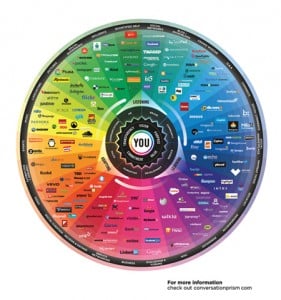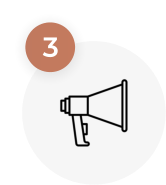According to Mashable, 100,000 tweets are shared, 347 website blog posts are published, 48 hours of YouTube videos are uploaded and 571 websites are launched to the world-wide-web every minute of every day (and those numbers continue to grow year on year).
On its own, that’s a huge amount of published content. But add to that the social-media-sphere and what you have is a never-ending volcanic plume of content being promoted and accessed from a plethora of channels.
 Brian Solis and JESS3 share this infographic, The Conversation Prism. It is a visual map of the social media landscape, and an ongoing study in digital ethnography that tracks dominant and promising social networks and organizes them by how they’re used in everyday life.
Brian Solis and JESS3 share this infographic, The Conversation Prism. It is a visual map of the social media landscape, and an ongoing study in digital ethnography that tracks dominant and promising social networks and organizes them by how they’re used in everyday life.
As marketers, what this graphic isn’t intended to do is overwhelm us or make us tear our hair out and wonder how we can possibly generate content that will get through all this noise (although this is a key question you need to include in your marketing plan).
The bigger picture is illustrated neatly here in this quote from a US-based marketer and thought-leader, Jonathan Pevelman from Buzzfeed
[grey-box]
“Content is King. Distribution is Queen and she wears the trousers”.
[/grey-box]
Here’s the problem – a consumers ability to consume content is limited and great content goes unread everyday. So what is the challenge we face? Should we be concentrating on creating more content or better quality content? Or both? Well, neither actually. You see those are the wrong questions to be asking…
This is not a content problem. It’s an audience problem.
A content distribution strategy can help put your content in front of your ideal audience instead of wasting time on channels that don’t fit the audience.
If you are a fashion brand for example; then it is likely you are going to have more success sharing engaging content via Facebook or Pinterest (other channels are available!) as these are places your customers are likely to be spending their time. There would be little point in focusing on LinkedIn when you are trying to sell sports shoes for example.
However, if you are a business owner looking to network with other businesses then being active on LinkedIn will be more beneficial to you.
Research, Research
For those of you who would like to engage better you need to be thinking more like this;
- Research Your audience
- Research Suitable media channels
- Be creative!
- Actively promote your content
- Create a conversation
- Measure effectiveness
 For those of you who don’t ‘get-it’ and think social media is a waste of your time and marketing spend, we think you might as well be trying to ride the road of success on one of these;
For those of you who don’t ‘get-it’ and think social media is a waste of your time and marketing spend, we think you might as well be trying to ride the road of success on one of these;
If you are still overwhelmed, we can make light-work of your social media creation and distribution. See what we can do to help.




